Sally Ember's Blog, page 49
March 16, 2016
How do #authors actually find #readers? I’m stumped.
How do #authors actually find #readers? I’m stumped.
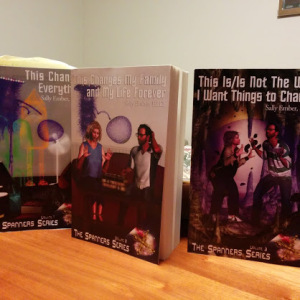
So far, since becoming a fiction author in 2013, I have spent time on most popular sites and established a presence on several, I have yet to find a lot of readers. I mostly find: authors (a LOT); those providing services to authors (even more); potential authors (a few); and, trolls (I block, but they do pop up).
I first published my ebooks via Smashwords which then distributed my ebooks for me to iTunes/iBooks, nook (Barnes & Noble), Kobo and many other affiliates globally. I then published to Amazon Kindle. As of last fall, I now have paperback formats available via CreateSpace (where I offer discounts; see below) and Amazon as well.
You may ask: what else have I done, so far? A LOT!…
—I belong to several dozen and am active in several Facebook, LinkedIn and Google+ groups/communities and I am less active but do belong to a few groups on Goodreads.
—I have author and book pages pretty much everywhere they’re free to have and manage to update them regularly (I hope).
—I have posted my free ebook (see below) on dozens of sites that allow free books to be posted for free.
—My first Spanners Series ebook, This Changes Everything, is permafree.
—The second volume, This Changes My Family and My Life Forever, came out about a year ago and the third one, This Is/Is Not the Way I Want Things to Change, released last December, so I have the supposedly magic number of 3 books out, now.
—All 3 are out since late 2015 in both ebook and paperback formats.
—I offer discount codes for the paperbacks on my own site.
—I participate in occasional sales organized by two Facebook groups (Clean Indie Reads #CR4U and Fantasy and Science-Fiction Network #FSFnet) I am actively involved in (several per year).
—I give free ebooks to reviewers and always follow their guidelines and wait to be invited before sending the ebook to them.
—I have had more than a few reviews for each book, but not up to 50 for any (yet).
—I actively sought readers/reviewers on BuView and got a few but not as many as who accepted my free ebooks.
—I never pay for reviews or participate in review swaps.
—I post interesting, varied non-fiction content (never all about my books or asking others please to buy my books).
—I re-blog.
—I re-share posts.
—I thank others for re-sharing (not always).
—I retweet (but not everything).
—My posts go up on many sites.
—My WordPress blog is cross-posted on Tumblr and on several other sites automatically.
—I re-post my own on Pinterest and StumbleUpon about once a month, to give them another set of views.
—I put most of my Google+ posts into Collections about once/month, which also gives them a boost in views.
—I do occasional reviews, usually outside my own genre (#scifi) and post my reviews on Goodreads, Amazon, and sometimes my own blog as well.
—I invite and host guest bloggers on my site.
—I guest blog/give interviews on others’ sites regularly.
—I have articles/reviews that have appeared on very popular sites, some of which have paid me for my posts.
—I have buy links, interview and review links and other links on my own site (look right; scroll down).
I am frequently on…
—Twitter.
—Facebook with both an individual and a Spanners Series page.
—Google+ with both an individual and a Spanners Series page.
—Pinterest, with many Boards and not all related to my books, either.
—YouTube (I have my own channel and a video talk show, CHANGES conversations between authors, since 8/2014 and posted book trailers, author readings).
—LinkedIn.
—I started a Patreon #crowdfunding campaign over a year ago, but haven’t garnered much dough.
I am also on/use…
—Authors’ Database
—Authors’ Den
—New Book Journal
—Koobug
—Bublish
I am occasionally on …
—Goodreads.
—Library Thing.
—Shelfari.
—BookLikes.
—and other many other author/book sites.
—I visit and comment on many blogs.
—I have been on and listen to/comment on a few Blog Talk Radio shows’ sites.
—I was on Authonomy (it closed, but I did get some great reviews from posting my WIP on that site) and am still on Wattpad with excerpts.
—I used the Pre-order function, with half-price discounts for all three ebooks, several weeks prior to each book’s release on Smashwords and Amazon and other sites.
—I post excerpts from my books while they’re in Pre-orders on my blog.
—At the end of each book, I post the first Chapter of the next volume in the The Spanners Series.
—I post a CTA (Call To Action) asking for reviews, followers and readers at the end of each book.
Started but stopped…
—I joined and posted for a while on Ask the Expert and Quora, but got too busy to keep doing that.
—I joined Reddit but I hated the way the monitors interacted with posters and the rules are too rigid, so I quit.
—I joined Medium and some other sites (can’t even remember them all) but hardly use them. Apparently I have followers, but unless my blog is cross-posted on a site, I don’t know what they are following.
I’ve learned to do/decided to do these actions and listings because I spent a lot of time researching prior to and since publishing my first ebook. I read and followed the instructions for “how to find readers” from many “experts,” but I still usually encounter the above categories of people. Not to say authors and others aren’t readers, but I’m looking for those who identify as such and not elsewise in the industry.
I want more people to read, review, enjoy and comment on my books: doesn’t everyone?
How do YOU attract more readers?
How do you know what works among all the things you’re doing to market yourself and your books?
All suggestions and anecdotes welcomed, except forget recommending I go on Instagram. I hate that site.
Thanks!
Sally Ember, Ed.D.
Please comment here: http://www.sallyember.com/blog or email me: sallyember AT yahoo DOT com
Filed under: All Volumes, Indie or Self-Publishing, Marketing, Personal stories, Science Fiction and Fantasy, Social Media, The Spanners, Writing Tagged: authors, Book Reviews, readers, Sally Ember Ed.D Author, social media, The Spanners Series








March 9, 2016
“Skills I Don’t Have”: reblogging from Sally Ember, Ed.D.,’s Guest Post on Charles Yallowitz’s site in December, 2015
Thanks to author and blogger, Charles Yallowitz, who was my guest on Episode 9 of CHANGES conversations between authors and is in my Guest Bloggers’ Hall of Fame, for inviting me to be a guest on his site today (12/10/15) which occurs during the week of the release of another in my #scifi (science-fiction)/ #romance/ #multiverse/ #utopian/ #paranormal (psi skills) series for adults/Young Adults and New Adults: Volume III, This Is/Is Not the Way I Want Things to Change, of The Spanners Series, now available in both ebook and paperback formats.
This is also the season of my expanding both Volume I, This Changes Everything, and Volume II, This Changes My Family and My Life Forever, into paperback formats on #CreateSpace and #Amazon.
Please check below and on my website for blurbs, covers, links and more information as well as #discount codes!
Skills I Don’t Have
Yes, I do have a lot of skills, talents, experience areas and abilities. BUT, there are many I lack and never so obviously as these last two months, as I attempted and finally succeeded in getting Volume III of my science-fiction ebook series to completion, in time for its 12/8/15 planned release date and all three of The Spanners Series‘ first Volumes into paperback format (after not having been able to work on the half-finished draft for over a year or to think clearly or organize appropriately and while still being very slowed down and impaired as well as fatigued from a TBI [Traumatic Brain Injury] in April, 2014).
I had no idea how to approach getting my ebooks (which I had formatted myself [pre-TBI], using Smashwords’ excellent Guides) into print formats for paperback sales. I knew they needed to be reformatted but I had no experience with making that happen.
I also am very limited, even pre-TBI, with layout and desktop publishing: mechanical, physical, graphic art-type skills and software are not my things. I don’t have much experience with Adobe Create Suite and do not own that program. I don’t do newsletters on the newer software and don’t have any art ability whatsoever.
My mottos: keep trying and ask for help.
When it doesn’t work (the first dozen times!), keep trying.
When I can’t figure it out (after days of attempts), ask for help.
Fortunately, I have a great cover artist, WillowRaven, for The Spanners Series’ ebook covers. She and I collaborated on all three of my covers and plan to for the next seven: I provide ideas and some photos; she does the deciding-what-works and the actual art.
I can’t draw.
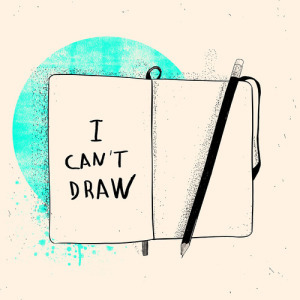
image from http://designyoutrust.com
Therefore, since I knew from previous conversations that I needed new covers, I started the paperback conversion process by emailing with WillowRaven. She immediately wrote back that I should have told her from the beginning I wanted paperback formats and that it would have been a lot easier/better if she had created those versions first.
Challenge number one. But, that damage was not irreparable, luckily.
From our email conversations and other research I had already done, I realized I needed to incorporate with my own imprint. I next emailed with local writers/ publishing network folks and found out what to do.
It took a few days, but I managed to name, create and start my own imprint, Timult Books, complete with free logo (Thanks, Logo Garden!).

I then learned how to get (from Bowker) and found out about a huge sale on (thanks for my online network!) my first self-owned ISBNs. Registered Timult Books with the state and Bowker, bought 20 ISBNs at a great discount and was then ready to send the extra materials (blurb, review quote—for the new back covers and “spines”) to Willowraven.
WillowRaven also needed accurate page counts so that the covers would fit correctly. I had never put my ebooks into print before and had no clue how many pages each book was (about 130K words), especially given the new sizing (5″ x 8″) and formatting (mirrored margins, with inner at 1.25″ and the rest at 0.5″). I also found MANY inconsistencies and typos that had to be corrected for each Volume as I reformatted, which changed the pagination as I went along.
Plus, paperbacks require and I decided to add some new pages of “front matter.” Then, I added a new page of “back matter” about the series.
It took me several days and many attempts to get the formatting right on CreateSpace (with lots of help from online forum people, Facebook group members and others: THANKS!)
AND, for whatever reasons, every time my computer went to sleep, the formatting reverted from 5″ x 8″ to 5″ x 7.99″ and changed the margins!!!??? I had to check each time I reopened the document, for each section (there are more than a dozen), to make sure they were correct AGAIN before converting each Volume to a PDF for uploading the new versions to CreateSpace for approval.
So, of course, the first page counts I sent WillowRaven were WRONG.
As were the second batch.
Third time, CHARM.
The three new paperback “wrap” covers were ready very quickly. Thanks, Aidana!
Fail better.
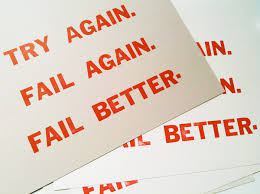
image from http://stuffaverylikes.com
I know a lot about MS Word and use Open Office’s version of it, but there are still many formatting details I’m unfamiliar with and don’t understand. I read many online forum posts, instructions online, etc., and STILL don’t understand some of that (TBI problems, I’m sure).
Why do the page numbers keep changing when I move a page break?
What’s with the “CONVERT” and “NEXT CONVERT” Sections thing?
Why do my running headers not always “run”?
Why does my computer’s “sleep” mode tell Open Office to revert its formatting?
I am IRRITATED beyond description and very impatient by the fourth day of these glitches. But, I persevere. Another good thing for this time period: I’m not around a lot of people.
Incompetent and Annoying.

image from http://quotesgram.com
I do finally get everything to work well enough to upload and order my proofs. So excited when they arrive, but then I start reading them aloud.
OY, VEY!
SO HUMBLING!
Despite my own and others’ having proofread each Volume, reading each book aloud allows/forces me to notice a ridiculous number of typos, inconsistencies, mistakes and other things that must be fixed on EACH PAGE! I had to use long-form, lined post-its to list each mistake because I had to mark each page multiple times. Every few pages had a post-it filled with edits to be made.
I ended up with hundreds of fixes needed to input in order to complete the revision of each of the books, all to be accomplished without changing the starting page of any Chapter or section (didn’t want to have to change the Table of Contents AGAIN, which I had done by hand since I couldn’t figure out how to have it happen automatically), and WITHOUT CHANGING THE PAGE NUMBER TOTALS!!! (see above)
The space between my skills level and what I needed to get these tasks done on my timetable was growing daily. Also, the TBI-induced fatigue and slowed-down aspects made everything take many times longer than pre-TBI.
Mind the Gap.

image from http://www.brillianceflooring.com
Once I had the proofs proofed, I could re-submit them and then they were ready to be sold.
Yeah! It’s happening! I have paperbacks!
I have been hearing from family and friends that “if only you had your books in paperback, I would read them.” Now, I do! So excited!
I emailed and messaged everyone the great news! Now, those without ereaders or those who don’t like reading longer books on them CAN read my books. I even sent them discount codes, specially large, just for my friends and family.
I sat back and awaited the sales to come pouring in (I have a large family and dozens of colleagues and friends on that email list).
Two weeks later: I have sold one book.
ONE.
Nothing can mend a broken heart (except the old BeeGees, of course). And, duct tape.
Duct tape for every repair.
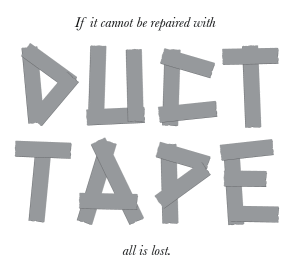
image from http://www.destinationmadness.be
Okay. Perhaps science-fiction novels, especially those that are over 500 pages long, a unique mixture of Ursula K. Le Guin, Tom Robbins, Robert Heinlein, Sherri Tepper and Marge Piercy with a little of Linda Hirschhorn and His Holiness the XIVth Dalai Lama mixed in, aren’t for everyone.
But, ONE sale from all of those who supposedly love/like and support me? That’s close to two hundred people!
I know I have trouble connecting the dots….These kind of tests, below, confound me, even pre-TBI.
Limited Spatial Intelligence.
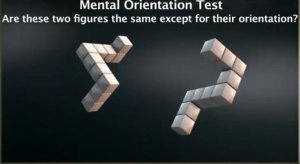
image from http://www.sciencedaily.com
But, even I know what one book sale in two weeks means (week ending December 5, 2015, as I write this post).
It’s too soon! Chanukah doesn’t start until December 6 and Christmas is weeks away!
I come from a family and friendship circle of procrastinators! I am one of only a handful who gets things done early or on time. Really! They’ll start buying/gift-giving soon. I’m sure of it.
Right?
Still learning (at age 62).
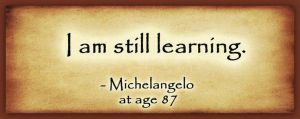
For those who are ready to gift-give and/or add to your own to-be-read lists, here you go:
Three paperback books here.
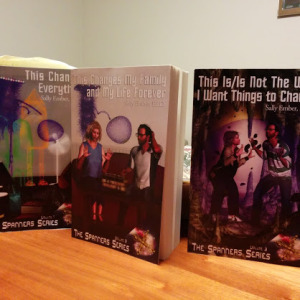
NOW available in #paperback on #CreateSpace and on Amazon:
This Changes Everything, Volume I, The Spanners Series by Sally Ember, Ed.D., is only $17.99 in paperback https://www.createspace.com/5837347
and FREE as ebook everywhere ebooks are sold, such as http://www.amazon.com/dp/B00HFELTG8
https://www.smashwords.com/books/view/376197
This Changes My Family and My Life Forever, Volume II, is $19.99 https://www.createspace.com/5844431
ebook @$3.99, https://www.smashwords.com/books/view/424969
http://www.amazon.com/dp/B00KU5Q7KC
This Is/Is Not the Way I Want Things to Change, Volume III, is $19.99 https://www.createspace.com/5844474
ebook @$3.99 https://www.smashwords.com/books/view/588331
http://www.amazon.com/dp/B0177Z1KRM
Happy Holidays!
Go to my website: http://www.sallyember.com/Spanners for book trailers, blurbs, discount codes and more!
#scifi #romance #utopian #adults #YA #NA #fiction #createspace #selfpublishing #indiepub #indieauthor #formatting #ebooks #paperbacks #TheSpannersSeries #SallyEmberEddAuthor #CHANGES
Filed under: Blogging and others' content, Life lessons, Personal stories, Writing Tagged: Charles Yallowitz, CreateSpace, lacking skills, new release, paperbacks, Sally Ember Ed.D Author, The Spanners Series, This Changes Everything, This Changes My Family and My Life Forever, This Is/Is Not the Way I Want Things to Change








March 2, 2016
8 Sound Sculptures That Lets Nature Be The Musician
While most sculptures are intended to be viewed, there are some that strive to stimulate our other senses as well. These eight large scale sculptures are installed at various locations around the world, and interact with natural forces like the wind and the rain to create soothing music. Let’s hear them.
Singing Ringing Tree, Burnley
The Singing Ringing Tree in Burnley, in Lancashire, England, is 3-meter tall and comprises of galvanised steel pipes of differing lengths and with holes punctured into the underside. When the wind blows, the sculptures produces an eerie sound in several octaves. Completed in 2006, the Singing Ringing Tree is part of the series of four sculptures within the Panopticons arts and regeneration project created by the East Lancashire Environmental Arts Network (ELEAN).

Aeolus Wind Pavilion, London
The Aeolus Wind Pavilion stands at London’s Canary Wharf and is composed of 310 stainless steel tubes that terminate…
View original post 735 more words
Filed under: Writing








March 1, 2016
#Writers Reach New Markets, #Translationpromotion English-Spanish @ 50% OFF…
From Olga, one of my earliest guests on my video talk show, CHANGES conversations between authors, and a guest blogger on my site, who is offering her translation services at 50% off to authors who read and respond to her post!
Added bonus: Olga is an author herself of both fiction and nonfiction, as well as a physician, psychiatrist and forensic specialist, so send her your mysteries, romances, police procedurals and anything else!
Those of you who have been following my blog for a while will know that apart from writing, reviewing books, and talking about books, I also translate books from English to Spanish and from Spanish to English…
Source: #Writers Reach New Markets, #Translationpromotion English-Spanish @ 50% OFF…
Filed under: Writing








February 29, 2016
Video of #Tibetan #Buddhist Center in Brazil that is part of my #Sangha
If there is a companion video to this excellent one of our sister sangha and main center in Brazil, Chagdud Khadro Ling, for Chagdud Gonpa’s Rigdzin Ling in California, our main center, I don’t know of it. If you do, please share! If you’ve already seen this, sorry for the repetition.

Khadro Ling‘s main temple in Tres Coroas, Brazil.
In Portuguese with English subtitles, beautiful photography and informative narration and scenes of #Tibetan #Buddhist practice, shrines, temples, items, meditation and practitioners, this video captures the quality and feeling of the land, buildings, intention, activities–the ambiance–very well.
The center (Rigdzin Ling) I spent so much time in from 1999 – 2008 (first visited in 1989; did up to 11-week-long retreats there, two more that were 6 -7 weeks and several that were 2 – 4 weeks, silent retreats, and several 11-day-long ceremonies/meditation practices, Drubchods) is in northern California between Eureka and Redding, but it looks a lot like these photos and our practices are the same.

Rigdzin Ling‘s main temple, Tara House, in Junction City, CA USA
For those who do not know, some background: This is my sangha (spiritual community of practitioners and teachers), started by my original teacher, His Eminence Chagdud Tulku Rinpoche, the teacher discussed in this video. Rinpoche passed in 2002. His newest (15th) incarnation/yangshi/tulku is about 10 years old, now.

H.E. Chagdud Tulku Rinpoche in 2001 and his yangshi in about 2009
To give perspective, Rinpoche was a contemporary of His Holiness the 14th Dalai Lama: they studied with many of the same teachers before the Chinese invaded Tibet and both escaped to India in 1959 as young men. Rinpoche came to the USA (California) in the mid-1980s with his American wife (second), Jane, who became known as Chagdud Khadro (in the video as well). They started building centers along the USA’s West Coast. In 1991, as the video states, they visited South America/Brazil and moved there in 1995.

Tulku Jigme Rinpoche (Rinpoche’s son), Chagdud Tulku Rinpoche, and Chagdud Khadro, Brazil, 2001
The person Rinpoche designated to be his spiritual heir and director is my root/main teacher, Lama Padma Drimed Norbu, known as Lama Drimed.

Lama Drimed, forest ceremony (tsog), 2013
May all beings benefit, all Lamas live long and continue to teach, and all practitioners continue to meditate and serve all beings.
Watch the video here:
or
https://www.youtube.com/watch?v=S0d5KoF8288
or
For more information: http://www.chagdud.org
Enjoy! Write back with comments, questions! Share!
http://www.sallyember.com is my main site and blog and has info about my Buddhist-themed science-fiction/ romance/ utopian/ multiverse novels, with discount codes and links, reviews, book trailers, more, about the first 3 ebooks and paperbacks in The Spanners Series, as well as posts about my #meditation practice and retreats.
Filed under: Buddhism, Meditation, Personal stories, The Spanners, Tibetan Vajrayana Nyingma Tagged: Brazil, Buddhism, Buddhist, Chagdud Tulku Rinpoche, His Holiness the 14th Dalai Lama, Lama Drimed, Lama Padma Drimed Norbu, meditation, retreat, Sally Ember Ed.D Author, The Spanners Series, video








February 22, 2016
Advocacy, Entitlement and Knowing When to Complain: The Rights of Poor People
Advocacy, Entitlement and Knowing When to Complain: The Rights of Poor People
If you are new to this blog, you may not know that I was in an accident about two years ago that resulted in a broken nose and concussion as well as other injuries. The concussion was not one of the “good” kind, meaning, I have still not completely recovered.
This deterioration in my health caused me to run through my savings and unemployment benefits in California and have to rely on others. Finally, I am privileged to benefit from my mother’s having space and a generous heart, allowing me to move in with her in St. Louis about 18 months ago.
Missouri, however, is not a great place to live if you are indigent. This post is the third in a series about my experiences here. This third one is on poor people’s rights. The second was on food for indigent people in Missouri (published February 16, 2016, http://wp.me/p2bP0n-1BL). The first one was on health care (published February 9, 2016, http://wp.me/p2bP0n-1By).
This post is important because it looks at the underlying issues that make a difficult situation (being poor) worse or better for each person. The intersections of perceived or claimed race/ethnicity, perceived or claimed gender, perceived or claimed social class, perceived or claimed age, home/best language, physical and mental health and (dis)abilities, perceived or claimed religion, perceived or claimed sexual orientation, and economic status in the city of St. Louis, Missouri, USA, in the mid-20teens, can adversely influence, improve or neutrally affect one’s experiences every moment.
“Intersectionality” is an important part of understanding how poverty impacts each person and family differently. Therefore, in this series, I need to bring in the politics of social identity. We all have to learn to address these overlapping oppressions and unfair treatments to help ourselves understand how everything is NOT actually “equal” regardless of the similarities in two people’s incomes.
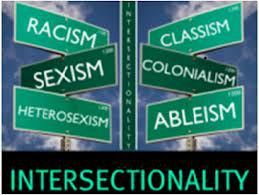
Intersectionality includes all of these components of one’s social identity.
It’s not “all good.”
It doesn’t have to be this way.
It ISN’T what it IS “naturally”: people and then institutions run by people make things this way and create/perpetuate systems that keep them this way.
Missouri is one of the worst places to be if you’re poor, but it’s not even the worst by any standards. Your experience all depends on the other components of your social identity. If you’re believed to be a white male, seemingly in good health and able-bodied, perceived to be heterosexual, assumed to be Christian, speaking mid-Western-accented English like a native, have at least some college education and otherwise seeming to be a USA “mainstream” guy between the ages of 25 – 65, you are going to be much better treated and fare better even when you’re poor than if you do not claim or cannot pull off having others believe you have all or any of those social identities.
If you’re also not a felon, have a place to live (a legal address) and (the use of) a car, you’re probably not going to be poor for very long.
Unless you’re obese. Unless you’re smelly. Unless you’re an addict. Unless you’re perceived to be “not one of us” in whatever way “us” is defined: then, you’re in some trouble. But, even with those cards stacked against you, as a poor assumed-to-be-white & -Christian with some education who speaks adequate English and can pass for straight and male and under age 65, you’re still going to be better off than anyone who isn’t.
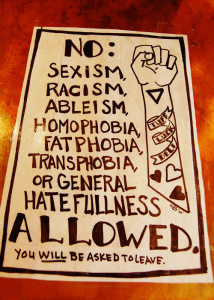
Change one aspect—gender—and things automatically get much worse. Change two—ethnicity/race and gender—and you’re doomed.
Check this out, from Everyday Feminism, June 20, 2015 by Carmen Rios “These 5 Statistics Prove That We’re Feminizing Poverty (And Keeping Women Down in the Process)” http://everydayfeminism.com/2015/06/feminizing-poverty/
— “Despite the overall poverty rate declining in America, 18 million women remain below the poverty line.”
—“Women are poorer than men in every state, regardless of education or geographic location. And for women of color, elderly women, and LGBTQIA+ women, it’s even worse.”
—“The poverty rate for Native American, Black, and Latina women is almost double the poverty rate for white women.”
—“For women, and especially women of color, the fight to raise the minimum wage to $10.10 or $15 is very personal—and could be the difference, for them, between barely surviving and finally thriving.”
—“…over a lifetime, women lose an average of $434,000 to the wage gap.”
—“One of the most important aspects of intersectional feminism is the understanding that when we fight for the most marginalized women, we liberate all women along with them.”
And, from other sources (see below) that add in education and other factors to race/ethnicity and gender with income levels:
—“White households take home between $10,000 to $20,000 more per year than their Black counterparts in every age bracket”
—“Enrollment in ‘high poverty’ schools for Black children is 41 percent, 38 percent for Hispanic children, 31 percent for American Indian/Alaska Native and a mere six percent for Whites.”
—“Even when Black and minority children attend mixed schools, they are more likely to be tracked into remedial or basic classes while their White counterparts take advanced, honors level courses.”
—“70 percent of students arrested or referred to law enforcement for school-related infractions were Black or Latino.”
—“While people of color only comprise about 30 percent of the US population, they account for 60 percent of those imprisoned.”
—“There is no such thing as unbiased, unpolitical education.”
—“People with ‘Black’ or ‘ethnic-sounding’ names are less likely to get callbacks for interviews.”
—“Blacks are more likely to be born into poverty and are less likely to escape it.”
—“Whites are 2-3 times more likely to make it into the middle class in their lifetimes compared to their black counterparts.”
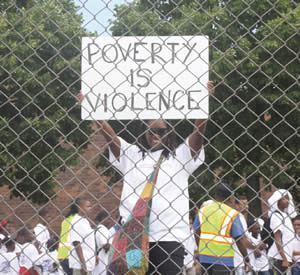
from http://iamarevolutionary.wordpress.com
Poverty IS violence. It has to stop.
Find a well-vetted nonprofit that advocates and works to end poverty and understands intersectionality and contribute, volunteer, blog about their work! Here is one: http://www.results.org/
Good news! We made this mess; we can clean it up.
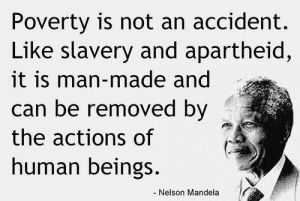
Nelson Mandela, Audre Lorde, Martin Luther King, Jr., Angela Davis, Gloria Steinem and so many more have spoken out about the nature of the human-made elements of our social and political systems and the oppressions they systematize.
WE are the ones who must advocate, complain, recognize that we are entitled to better and that so is everyone else, and ACT!
—Do not sit by and watch passively when others are mistreated, disrespected, unfairly scheduled or managed, especially when you are in any position of better privilege: it is your DUTY to advocate whenever you are able.
—Write letters, blog, make phone calls, picket, march, show up and let those in power know you are not satisfied with the “status quo.” Be specific.
—VOTE! It is your DUTY and responsibility as a USA citizen who can vote (if you are one) to use that right in EVERY election. It is the LOCAL elections that most affect people who live near you, and regional and state office holders who make laws that affect us all. Federal elections matter, too, but not as obviously or as immediately.
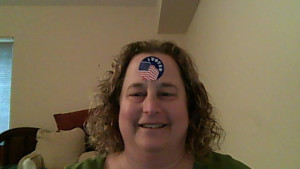 I VOTE! And, as of early March, I am working as a election-day supervisor at a local polling place!
I VOTE! And, as of early March, I am working as a election-day supervisor at a local polling place!
—THEREFORE, do not ignore bond issues, council and mayoral elections, county positions, state office holders’ elections and only vote on presidential ballots. ALL VOTES MATTER!
Want to know more? Have a read:
From October, 2015, inGenere.it: “Intersectionality. Putting together
things that are often kept apart” by Jeff Hearn
http://www.ingenere.it/en/articles/intersectionality-putting-together-things-are-often-kept-apart
From February, 2015, NPR: “Study: Black Girls Are Being Pushed Out of School” by Karen Grigsby Bates
http://www.npr.org/sections/codeswitch/2015/02/13/384005652/study-black-girls-are-being-pushed-out-of-school
From February, 2015, the the Frisky: “18 Things White America Needs To Reconcile To Truly Become Colorblind” by Tiffanie Drayton
http://www.thefrisky.com/2015-02-26/18-things-white-america-needs-to-reconcile-to-truly-become-colorblind/
If you appreciated this series, please reblog/share it, comment, ask to be a guest blogger and contribute your own point of view or write on a related topic: http://www.sallyember.com
This third post was on advocacy and intersectionality (published on February 23, 2016, http://wp.me/p2bP0n-1C2).
The second was on food for indigent people in Missouri (published February 16, 2016, http://wp.me/p2bP0n-1BL).
The first one was on health care (published February 9, 2016, http://wp.me/p2bP0n-1By).
Filed under: Life lessons, Opinions, Personal stories, Support for Good Causes Tagged: Advocacy, age, classism, concussion, education, entitlement, ethnicity, feminism, gender, intersectionality, Missouri, Poor people, poverty, race, rights, TBI, voting








February 21, 2016
Mazel Tov to the FINALISTS: 2015 #NebulaAwards!
Congrats to the 2015 Nebula Award nominees!
Invitation to each of them to be a guest on my online video talk show, CHANGES conversations between authors!
Readers and Authors, watch CHANGES Episodes on my YouTube channel, over 45 shows archived: https://www.youtube.com/playlist?list=PLPbfKicwk4dFdeVSAY1tfhtjaEY_clmfq
If you are an author, visit and read about how to become a guest on my CHANGES page:
https://sallyember.com/changes-videoc...
Source: Comment on FINALISTS: 2015 Nebula Awards (With FREE FICTION Links) by Soon Lee
Filed under: Writing








February 19, 2016
The #gender-industrial complex, Part VI (Teens and twentysomethings)
How to #write a One-Page #Synopsis & Write a #Query Letter #Infographics…
Reblogged on WordPress.com
Source: How to write a One-Page Synopsis & Write a Query Letter Infographics…
Filed under: Writing








February 15, 2016
Food Stamps and Food Issues for Poor People in St. Louis
Food Stamps (SNAP, EBT) and Food Issues for Poor People in St. Louis
If you are new to this blog, you may not know that I was in an accident about two years ago that resulted in a broken nose and concussion as well as other injuries. The concussion was not one of the “good” kind, meaning, I have still not completely recovered.
This deterioration in my health caused me to run through my savings and unemployment benefits in California and have to rely on others. Finally, I am privileged to benefit from my mother’s having space and a generous heart, allowing me to move in with her in St. Louis about 18 months ago.
Missouri, however, is not a great place to live if you are indigent. This post is the second in a series about my experiences here. This one is on food for indigent people in Missouri. The first one was on health care (published February 9, 2016, http://wp.me/p2bP0n-1By).
This post is about the government-subsidized “food support,” formerly called “Food Stamps,” now called “SNAP” for Supplemental Nutrition Assistance Program.
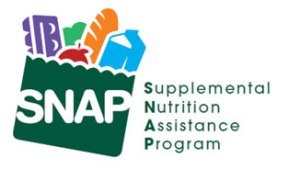
What makes Missouri so bad for poor people? For one thing, this state is very Republican-dominated. Despite many of the speeches given by congressional and senatorial representatives from this party, their votes speak loudly: they keep lowering the amounts poor people can receive in all types of assistance and have repeatedly voted to reduce food support. This state also still calls its program “Food Stamps,” but adds “SNAP” so people will know what it is. http://dss.mo.gov/fsd/fstamp/
Missouri’s unfortunate and lethal combination of machismo, arrogance, obstinacy and ignorance have caused millions of Missourians who cannot afford to buy sufficient amounts or types of food for themselves and/or their children to go without food, especially near the end of each month’s benefits period (the food money runs out). Not only are the benefits woefully and abysmally low, even at their highest levels, they arrive in one lump at the beginning of each monthly period. Even the best budgeters can’t make insufficient funds last throughout a month.
“Missouri is among states where legislators this year have considered bills that would curb welfare benefits” and continues to demonstrate its disdain for the poor, blaming the victims and putting economic pressure on the weakest of us to try to shore up the state’s failing budget. The Democratic Governor, Jay Nixon, vetoes these bills, but then the “representatives” usually have the votes to override his vetoes. On it goes, this heinous battle for who can sink the lowest first. http://www.huffingtonpost.com/2015/05/04/missouri-welfare-restrict_n_7209458.html
Missouri and other state SNAP programs are now in the computer age. SNAP currently issues a debit-type card to recipients which is an EBT (Electronic Benefits Transfer) unit that looks a lot like any other debit card. I’m sure this has alleviated a lot of the embarrassment many users had previously felt when producing their pink paper food stamps at the grocery check-out line. Now, we kind of “blend in,” putting our card through the same reader everyone who uses credit or debit cards uses to make our payments.
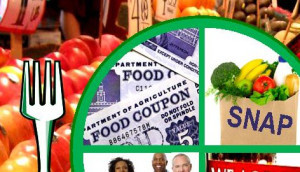
from http://www.snaptohealth.org
Except when we don’t. Most times, even when I tell the register operator that I am using an EBT for SNAP, they punch in the wrong codes and it doesn’t work. Or, they do it correctly, but neither of us knows exactly how much the receipt total will be for until the card is used (SNAP card users get to avoid paying the tax on food that others pay). Worse, there is no way prior to being in the check-out process for a user to know exactly how much is left on the EBT to use.
Here is a typical process for me.
—I get in line (can’t use the self-service machines for EBT/SNAP)
—I put my food on the conveyor
—I get to the card reader while the register operator is still scanning my food so that I am sure to mention to him/her that I am using SNAP
—S/he nods or otherwise acknowledges that I told him/her this (important to get confirmation: they often do not hear me or don’t know what I mean)
—I put my EBT card through the reader.
Hopefully, it reads my card correctly (doesn’t always) and
—I press the right buttons (always confusing, since the buttons are arranged differently in every card reader I’ve seen, so far: not always using the same colors designating the choices or putting the choices in the same position)
—We get to the end of the food scanning
—S/he presses whatever buttons (not always correctly) to accept my EBT card as payment
—I either do or do not have sufficient funds on the card to pay for this amount of food (which I only know at this point)
—If so, we proceed and I am done
—If not, we have to start over with the reader, putting only the amount I actually have into the register operator’s process to take only that amount from my EBT
—Then I have a choice: pay in cash or use a debit card (if I have the funds) for the rest, or put the rest of the food back/don’t take it home.
I think it’s obvious that this process is not quick, or at least, not as quick as using cash or a debit/ credit card. When the lines are long, I dread getting into one because these “delays” cause impatience to arise in those in line behind me. I have a fairly thick skin, so to speak, so I don’t care about how impatient people are. We all have to wait, sometimes.
However, others do care about others’ opinions, so it makes many SNAP users anxious to go through the check-out process, as you can well imagine. Many times, when I was more flush, I gave the SNAP users in lines ahead of me some money when their EBT cards were shown to carry insufficient amounts for the entire purchase and the users clearly didn’t have any cash or funds to cover the rest of the food.
Confession: I was less likely to offer money when the purchases of the SNAP user seemed “frivolous” or “junky” to me. Awful judgment call on my part and really, none of my business. But, at the time, I felt quite high-and-mighty, telling myself I was “doing them and their kids a favor” if they didn’t get to bring home that sugary or salty treat. Why, I wonder now, does anyone believe we suddenly have the right or ethical duty to pass judgment on someone’s food purchases simply because they’re poor? We leave all the horrible choices of the middle- and upper-class to themselves, so why do we believe we are entitled to assess those of the poorest among us?
News flash; poor people are not stupider, less informed, less competent or any other judgment the better-off can levy just by being currently without enough money. Money does NOT make anyone smarter, more informed, competent or anything else, automatically. We all know plenty of wealthier people without a clue, don’t we?
In other horrible news, SNAP makes us “re-qualify” every year even if our benefits are for a two-year period. This means recipients are able to be—and, in my case, I was—penalized if we earn even a little bit of money. My SNAP benefits were reduced by half (and were insufficient to begin with) when I reported that I had earned some income from freelance proofreading/editing and doing occasional childcare, even though the total earned was less than $1000/month and more often, not even half that. Look at the chart below for how low these monthly benefits are for an entire month and picture this: you have ONLY this amount to pay for all food for 4.3 weeks (30 – 31 days):
Family size: 1 2 3 4
Maximum benefit level: $155 $284 $408 $518
So, if you’re math-impaired, consider these actual figures:
—the individual SNAP allotment comes to about $36/week, or $5.14/day per individual.
—For a family of two, it comes to $33/week/person, not even $4.70/day, which is LESS per week than if you’re on your own.
—For a family of three, usually one parent and two children, they get only $32/week/person, which is $4.53/day per person!
—The larger the family, the less the family gets per person.
What is the logic, here? That kids eat less than adults? Incorrect, unless they’re under 7 years old.
Or, maybe they live in a fairy-tale land, in which they believe larger families can buy “in bulk.” Well, that only works if a family has enough money in hand to purchase the larger amount of chicken or rice or beans, which they often would not have, since the total amount provided by SNAP and workers’ wages is insufficient. When a family doesn’t have enough money to buy food, how can anyone buy MORE food per grocery visit?
Doesn’t work.
Over the last 2 years of my own experiences as a poorer person but one who has many resources others do not have (a great and safe place to live, family members to help me, a car, higher education and advocacy skills, among the best) and seeing these SNAP figures, above, I understand the motivation that spurs poorer people to become criminals just to make ends meet. Why the hell not?
I’m not advocating a life of crime, but I certainly can empathize the reasoning better, now.
When our government fails to support those in the most need, what are the needy supposed to do?
Meanwhile, some help is better than none. How can people get fed, then?
—If a family has young children or the mother is pregnant, that mom and kids can also get further food support (very restricted, but food and juice, nonetheless) from WIC (Women and Infant Care) and (minimal) cash from TANF (Temporary Aid to Need Families, formerly known as “welfare”).
—If one is disabled and/or a senior, one can get Social Security disability and/or retirement benefits to supplement these paltry SNAP monthly allotments.
For basic SNAP information and links to your state’s SNAP website: http://www.fns.usda.gov/snap/supplemental-nutrition-assistance-program-snap
Good news! Many health food stores, farmers’ markets and alternative grocery stores now accept SNAP.
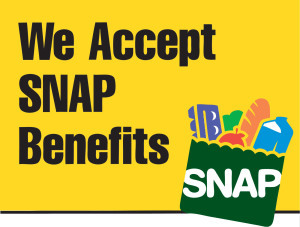
However, the poorer among us face an entirely different problem that I personally don’t experience (that good fortune is due to my being able to live with my mom). Those who live in “high-poverty” areas now often inhabit regions that have become what are known as “food deserts”: because the larger chains and independent grocery stores refuse to locate or stay in these neighborhoods, there is literally nowhere to go grocery shopping. If you live in a “food desert,” you are screwed. Bad enough that you already have less means (no car, no money for gas), horribly skimpy SNAP funds and little time (those who do have jobs work hourly and must show up on time and leave when they’re scheduled to leave, period). You now are somehow also supposed to travel great distances (often when there is no viable public or any public transportation, so how are you going to accomplish that?) to get to a decent, fairly priced grocery store or to get anywhere that sells any fresh food at all.
People who live in “food deserts” can sometimes purchase food that is close to where they live, but it is usually from “convenience” stores or gas stations’ stores. Their “food shelves” and “hot bars” are typically stocked with low-nutrition, high-fat, high-sodium, high-sugar, deep-fried or microwavable, high in “empty” (simple) carbs, over-priced options only: no fresh fruit, no fresh vegetables, not much good protein, almost no complex carbs and very few choices that are even close to being healthy.
YOU might be able to help change this! https://www.dosomething.org/facts/11-facts-about-food-deserts Help populate “food deserts” with good food sources and/or bring better public transportation to these areas.
And, just when you thought things couldn’t get much worse, now it’s 2016. SNAP recipients between ages 18 – 49 stand to lose what little SNAP benefits we do get if we aren’t working “sufficiently,” but more of us than ever still need SNAP and many cannot work or work “sufficiently.”
Want to know more? Have a read:
From January, 2016, Cleveland.com: “Over 1 million face loss of food stamps over work requirements”
http://www.cleveland.com/nation/index.ssf/2016/01/over_1_million_face_loss_of_fo.html
From January, 2016, American Enterprise Institute: “Are SNAP benefits really too low?” by Angela Rachidi
https://www.aei.org/publication/are-snap-benefits-really-too-low/
From February, 2016, the Times-Picayune of Greater New Orleans: “Despite ‘recovery,’ more Americans using food stamps, at a higher cost”
http://www.nola.com/politics/index.ssf/2016/02/despite_recovery_more_american.html
Next in this series, February 23, 2016: Advocacy, Entitlement and Knowing When to Complain: The Rights of Poor People http://wp.me/p2bP0n-1C2
This second is on food for indigent people in Missouri, published on February 16, 2016, http://wp.me/p2bP0n-1BL.
The first one is on health care, published on February 9, 2016, http://wp.me/p2bP0n-1By.
The third post is/was on advocacy and intersectionality, (to be) published on February 23, 2016, http://wp.me/p2bP0n-1C2.
Filed under: Life lessons, Opinions, Personal stories Tagged: concussion, EBT, food, food deserts, Food Stamps, Missouri, nutrition, poor, poverty, SNAP, TBI




















